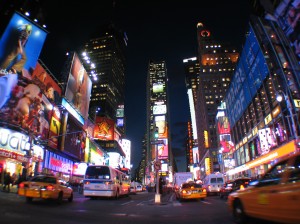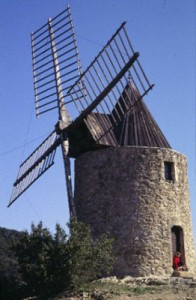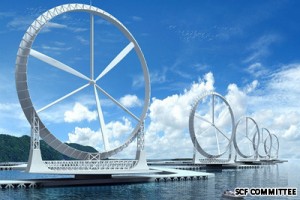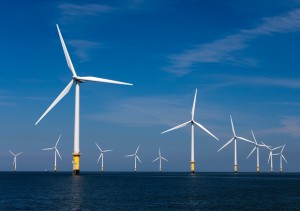 When asked about the most quintessentially “New York” experience, Manhattanites will likely rave about some swanky rooftop club on top of a hotel, running along the Hudson through Riverside Park, or the amazing chocolates that can only be found in Chelsea market. To an outsider, however, “New York City” can be represented with one image—Times Square. Massive skyscrapers that are relentlessly lit up with mega television screens, large crowds of people, and traffic littered with taxicabs.
When asked about the most quintessentially “New York” experience, Manhattanites will likely rave about some swanky rooftop club on top of a hotel, running along the Hudson through Riverside Park, or the amazing chocolates that can only be found in Chelsea market. To an outsider, however, “New York City” can be represented with one image—Times Square. Massive skyscrapers that are relentlessly lit up with mega television screens, large crowds of people, and traffic littered with taxicabs.

Each of the former images seems to represent the vivacity of the city; however, each also requires an excessive amount of energy.Taking the Manhattanite’s second suggestion to run along Riverside Park, visitors may be taken aback by the wide-open horizon sprinkled with sailboats. Within the juxtaposition between these two contrasting images of New York, it should be noted that that latter features a primitive technology that could be very relevant for powering the former—in this case sailboats harnessing wind for energy. With improvements in technology, harnessing energy from renewable resources to help alleviate the impact of fossil fuels seems attainable.
The Impact of Fossil Fuels
The progress seen in the developed world in places like New York City has been driven by a dependence on coal and petroleum-based fuel sources. As these energy sources are continually depleted by the comforts of the modern world, nations have felt the need to form alliances and wage wars in order to gain access to these valuable remnants. While these nonrenewables have indeed allowed for major technological advances including fast and easy transportation, readily available entertainment, indoor plumbing—in essence all the comforts afforded by the average American lifestyle—they have been exploited to an extreme degree. The US Energy Information Administration estimates that coal consumption for 2012 reached 889,185 thousand tons and natural gas reached 25,533 billion cubic feet; similarly, Americans consumed approximately 18,877 thousand barrels of petroleum per day. The massive consumption of these fossil fuels has contributed to over 6,000 million metric tons of carbon dioxide being released annually from the U.S. alone. The abuse of fossil fuels has had a significant negative effect on the global climate. The burning of fossil fuels produces carbon dioxide as a by-product, which increases the concentration of the greenhouse gas in the Earth’s atmosphere, and raises the earth’s temperature.
Current levels of carbon dioxide in the atmosphere are approximately 400ppm. While CO2 naturally fluctuates throughout the seasons and from year to year, average annual atmospheric values have increased nearly 100ppm since the onset of the 20th century. Simultaneously, average annual temperatures have also seen an increase of approximately 0.6oC. Increases in the atmospheric concentration of CO2 have likely been affected by the anthropogenic burning of fossil fuels and land use changes. In order to decrease the negative climatic effects of this atmospheric increase, the amount of CO2 entering the atmosphere must be drastically reduced. Due to budget constraints, lack of education and simple convenience, individuals seem unwilling to change their lifestyles, so efforts must be taken on a larger scale. For instance, energy companies should weigh the pros and cons of relying on limited energy resources like coal or oil versus a more sustainable alternative. Switching to a renewable resource would initially prove more costly for the company; however, the switch would allow for a reduction in coal and oil dependency and CO2 byproducts, while providing the company with long-term revenue.
From Medieval Windmills to Off-Shore Turbines and Lenses
 The same way that wind can be trapped in a boat’s sails to propel it forward, capturing the movement of air with rotating blades can be used to propel society forward. Windmills were initially designed with rotating sails that revolved around a vertical axis in the Middle East to assist with water pumping. When the technology was brought back to Europe, the Dutch in particular applied similar concepts. By rotating the plane of the windmill to a vertical position and attaching beams with frictionless iron bearings, the Dutch were able to harness energy for milling grains, transporting water, and even sawing timber. With the onset of industrialization in the 19th century, however, people turned to steam, coal, and eventually petroleum fuel sources to power new machines. With the oil embargoes during the 1970s, people began to look for more sustainable energy alternatives, and wind farming resurfaced. While initial prototypes contained large upfront costs and produced energy fairly inefficiently, modern designs are much closer to the mark. Farms containing hundreds of land-based turbines are able to produce approximately 1.6MW of power per turbine; however, Enercon, a German-based turbine manufacturer, has designed a new model to operate at 3MW.
The same way that wind can be trapped in a boat’s sails to propel it forward, capturing the movement of air with rotating blades can be used to propel society forward. Windmills were initially designed with rotating sails that revolved around a vertical axis in the Middle East to assist with water pumping. When the technology was brought back to Europe, the Dutch in particular applied similar concepts. By rotating the plane of the windmill to a vertical position and attaching beams with frictionless iron bearings, the Dutch were able to harness energy for milling grains, transporting water, and even sawing timber. With the onset of industrialization in the 19th century, however, people turned to steam, coal, and eventually petroleum fuel sources to power new machines. With the oil embargoes during the 1970s, people began to look for more sustainable energy alternatives, and wind farming resurfaced. While initial prototypes contained large upfront costs and produced energy fairly inefficiently, modern designs are much closer to the mark. Farms containing hundreds of land-based turbines are able to produce approximately 1.6MW of power per turbine; however, Enercon, a German-based turbine manufacturer, has designed a new model to operate at 3MW.
Even with the increases in efficiency, questions about placement arise. Land-based turbines often face opposition due to the fact that winds on land are unpredictable, and typically highest at night when residents do not actively need as much power. By moving wind farms into offshore locations and connecting generators directly to the energy grid, some of these problems fade. According to Mark Rodgers, the key correspondent for the “Cape Wind” project in Nantucket Sound, “offshore wind produces much more coincident with electric demand, so we will produce more power in the afternoons, and not as much at night, on average”. The benefits of moving turbines to off-shore locations has already been seen since as early as 1991 in Denmark, whose turbine projects power 28 percent of the nation’s total energy consumption. According to a report done by Michael Dvorak et al. of Stanford University in 2012, constructing approximately 140,000 5MW offshore turbines along the East Coast could provide up to 1372 TW hours annually, or enough to power the entire east coast of the United States.
Further progress can be seen in designs from Japan. In 2010, Yuji Ohya designed a “wind lens” to produce anywhere from two to three times that of a traditional turbine. The floating lens systems compound energy capture through the addition of a hoop around the rotating blades. While the machines seem futuristic, the design also reduces noise pollution, a common concern for both onshore and offshore turbines.
 The technology has arrived–can the United States let it take off with the winds of change?
The technology has arrived–can the United States let it take off with the winds of change?
